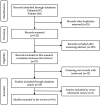Classification of neurodegenerative diseases using brain effective connectivity and machine learning techniques: a systematic review
- PMID: 40474923
- PMCID: PMC12139419
- DOI: 10.3389/fneur.2025.1581105
Classification of neurodegenerative diseases using brain effective connectivity and machine learning techniques: a systematic review
Abstract
Background: Effective connectivity (EC) refers to the directional influences or causal relationships between brain regions. In the field of artificial intelligence, machine learning has demonstrated remarkable proficiency in image recognition and the complex dataset analysis. In recent years, machine learning models leveraging EC have been increasingly used to classify neurodegenerative diseases and differentiate them from healthy controls. This review aims to comprehensively examine research employing EC-derived from techniques such as functional magnetic resonance imaging, electroencephalography, and magnetoencephalography-in conjunction with machine learning methods to classify neurodegenerative diseases.
Methods: We conducted a literature search in accordance with the Preferred Reporting Items for Systematic Reviews and Meta-Analyses (PRISMA) guidelines, collecting articles published prior to June 13, 2024, from the PubMed and Embase databases.
Results: We selected 16 relevant studies based on predefined inclusion criteria: six focused on Alzheimer's disease (AD), six on mild cognitive impairment (MCI), one on Parkinson's disease (PD), two on both AD and MCI, and one on both AD and PD. We summarized the methods for EC feature extraction and selection, the application of classifiers, validation techniques, and the accuracy of the classification models.
Conclusion: The integration of EC with machine learning techniques has demonstrated promising potential in the classification of neurodegenerative diseases. Studies have shown that combining EC with multimodal features such as functional connectivity offers novel approaches to enhancing the performance of classification models.
Keywords: Alzheimer’s disease; brain effective connectivity; classification model; deep learning; electroencephalogram; functional magnetic resonance imaging; machine learning; neurodegenerative diseases.
Copyright © 2025 Wang, Huang, Chang, Guo, Chen, Wang, Liu and Huang.
Conflict of interest statement
The authors declare that the research was conducted in the absence of any commercial or financial relationships that could be construed as a potential conflict of interest.
Figures



Similar articles
-
Graph Convolutional Network for AD and MCI Diagnosis Utilizing Peripheral DNA Methylation: Réseau de neurones en graphes pour le diagnostic de la MA et du TCL à l'aide de la méthylation de l'ADN périphérique.Can J Psychiatry. 2024 Dec;69(12):869-879. doi: 10.1177/07067437241300947. Epub 2024 Nov 25. Can J Psychiatry. 2024. PMID: 39584743 Free PMC article.
-
Application of advanced machine learning methods on resting-state fMRI network for identification of mild cognitive impairment and Alzheimer's disease.Brain Imaging Behav. 2016 Sep;10(3):799-817. doi: 10.1007/s11682-015-9448-7. Brain Imaging Behav. 2016. PMID: 26363784
-
An efficient ranking-based ensembled multiclassifier for neurodegenerative diseases classification using deep learning.J Neural Transm (Vienna). 2025 Jan;132(1):67-93. doi: 10.1007/s00702-024-02830-x. Epub 2024 Sep 9. J Neural Transm (Vienna). 2025. PMID: 39249515
-
Deep Learning in Alzheimer's Disease: Diagnostic Classification and Prognostic Prediction Using Neuroimaging Data.Front Aging Neurosci. 2019 Aug 20;11:220. doi: 10.3389/fnagi.2019.00220. eCollection 2019. Front Aging Neurosci. 2019. PMID: 31481890 Free PMC article.
-
Machine learning with multimodal neuroimaging data to classify stages of Alzheimer's disease: a systematic review and meta-analysis.Cogn Neurodyn. 2024 Jun;18(3):775-794. doi: 10.1007/s11571-023-09993-5. Epub 2023 Aug 18. Cogn Neurodyn. 2024. PMID: 38826669 Free PMC article. Review.
References
Publication types
LinkOut - more resources
Full Text Sources

